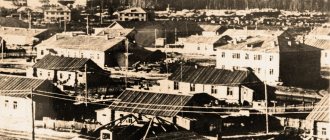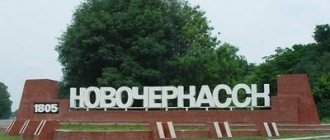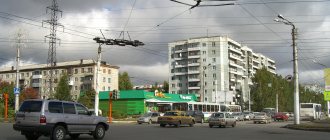Yugorsk appeared on the map of Russia in 1962. At the time of its founding, the settlement was named the Komsomolsky village. It arose at the site of logging in the Khanty-Mansiysk Autonomous Okrug as part of the Tyumen region.
- In 1987, the population reached 20 thousand people, and the village itself was recognized as the best in the district in terms of improvement.
- In 1991, a survey was conducted among the residents of the village about assigning the village the status of a city and renaming it.
- In 1992, Komsomolsky received the status of a city, at the same time it was renamed Yugorsk, after the name of the district.
- The city's population is constantly increasing. In 2022, about 37 thousand people lived in Yugorsk. The area of the city is 152.18 square meters. km.
Geographic information
Geographically, the city is located in the south of the North Sosvinskaya Upland, which belongs to the West Siberian Plain. At a distance of 5 km flows the small river Ess, a tributary of the Konda River. It borders with the Sovetsky district of Khanty-Mansi Autonomous Okrug. The capital of the Autonomous Okrug, Khanty-Mansiysk, is located 420 km away.
The terrain of the territory is predominantly flat, gently hilly. The city is located in the taiga zone, surrounded by forests, with a predominance of coniferous trees and an abundance of mushrooms and berries.
The region is located in a zone of sharply continental climate, with short warm summers and very long and cold winters, which is why the heating season is also long. In terms of natural and climatic working conditions, the territory is equal to the regions of the Far North. In the coldest month, January, the average temperature is plus 17.5 °C, in the coldest - minus 16.5 °C. The average temperature throughout the year is minus 0.7 °C.
Links
List of settlements in the district
Projects:
Portal:Ugra | Project: Yugra
Articles
: Geography | Coat of arms | Anthem | History | Population | Administrative division | Flag
Useful
See what “Yugorsk” is in other dictionaries:
Yugorsk is a city, Khanty-Mansi Autonomous Okrug. It arose in the post-war years as a village, c. large timber industry enterprise; since 1963 worker. village Komsomol. The name is typical for villages in areas of new development and was repeated many times in the past. THE USSR. In 1992 it was transformed into... ... Geographical Encyclopedia
YUGORSK is a city (1992) in the Russian Federation, Khanty-Mansiysk a. O. Railway station 26.5 thousand inhabitants. (1993). Oil production center ... Big Encyclopedic Dictionary
YUGORSK - YUGORSK, a city (since 1992) in the Khanty-Mansiysk Autonomous Okrug. Railway station. 29.1 thousand inhabitants (1998). Oil production center. Source: Encyclopedia Fatherland ... Russian history
Yugorsk is a city (since 1992) in Russia, Khanty-Mansi Autonomous Okrug. Railroad station. 29.1 thousand inhabitants (1998). Oil production center. * * * YUGORSK YUGORSK, city (since 1992) in the Russian Federation, Khanty-Mansiysk a. O. Railway station.... ... Encyclopedic Dictionary
Yugorsk is a city, Khanty-Mansi Autonomous Okrug. It arose in the post-war years as a village, c. large timber industry enterprise; since 1963 worker. village Komsomol. The name is typical for villages in areas of new development and was repeated many times in the past. THE USSR. In 1992 it was transformed into... ... Toponymic Dictionary
Yugorsk - 628260, Khanty-Mansi Autonomous Okrug, city ... Settlements and indices of Russia
Yugorsk 3 - 628263, Khanty-Mansi Autonomous Okrug, city ... Settlements and indices of Russia
Yugorsk 4 - 628264, Khanty-Mansi Autonomous Okrug, city ... Settlements and indices of Russia
Yugorsk - Yugorsk, a city in the Khanty-Mansiysk Autonomous Okrug, 420 km west of Khanty-Mansiysk. Located in the north of Western Siberia. Railway station Geological. Population 28.3 thousand people (1996). Founded in 1962 in connection with the construction... ... Dictionary "Geography of Russia"
Gazprom Transgaz Yugorsk - This article lacks links to sources of information. Information must be verifiable, otherwise it may be questioned and deleted. You may edit this article to include links to authoritative sources. This mark... ... Wikipedia
Source
General information
Yugorsk, Tyumen region, is located in the western part of the Khanty-Mansiysk Autonomous Okrug. The small town is the administrative center of the district of the same name. It occupies an area of 152.18 km². The population density of the city of Yugorsk is 244.12 people/sq.km.
A monotown, the city-forming enterprise of which is Gazprom Transgaz Yugorsk, a subsidiary of Gazprom that manages the largest gas transportation system in the world. Provides jobs for 30,000 people, of which about 6,000 are Ugra residents, the rest work on a rotational basis.
The city is home to the Geologicheskaya station of the Sverdlovsk Railway, which is capable of handling passenger trains with a length of 500 m and freight trains with a length of 700 m. Transportation is carried out in the direction Sverdlovsk - Priobye. Highways are of local importance only, with a total length of 130.2 km. The nearest airport in the city of Sovetsky is 15 km away.
Routes on the map of Yugorsk. Transport infrastructure
The satellite map shows that a railway runs through the whole of Yugorsk. From Geologicheskaya station, passengers can travel to Nizhny Tagil, Perm, Sovetsky, Yekaterinburg, and Nyagan. Since the station is not equipped with a loading area, freight cars are loaded and unloaded on the sidings.
15 km. from Yugorsk there is an airport operating domestic flights to Moscow, Yekaterinburg, Nadym, Tyumen.
Regional highways connecting Yugorsk with the town pass through the city. Taiga and from the city of Sovetsky. Intercity buses go to Krasnoturinsk, Yekaterinburg, Surgut, Khanty-Mansiysk, Nizhny Tagil.
City passenger transport is represented by buses and minibuses.
Founding of the settlement
The first population of Yugorsk was a team of 17 logging workers who reached these remote places at that time to harvest timber necessary for the construction of the Ivdel-Ob railway. This happened on March 21, 1962, although now the city’s birthday is celebrated on the first Saturday of September. It was planned to organize an Ess station at 175 km of the railway. Later, the next batch of workers arrived - tractor drivers and fellers. On the basis of the logging station, the Essky timber industry enterprise was formed, which in October 1962 was renamed Komsomolsky.
Quite quickly, the timber industry enterprise became a large diversified enterprise, which was engaged not only in timber harvesting, but also in its processing and harvesting of resin. The advanced enterprise became a pioneer in the introduction of new technology. The village grew quickly, the population increased, people from all regions of the large country came here to work. The first streets of the settlement were clearings lined with barracks and dugouts.
Main streets of Yugorsk
Main streets on the map of Yugorsk:
- st. Gastello. Street in the southwestern part of the city. Passes by Kedr Stadium. It houses the Amotea and Cosmic business centers, the Tax Office, and the Kedr and Sport hotels.
- st. Mira. One of the central streets crossing the city from the northern outskirts to the railway station. It houses school No. 2, the Yubileiny sports complex, the Museum of History and Ethnography, and the city gymnasium.
- st. Railway. The central street of the city runs parallel to the railway line. Nearby are the railway station, the Ice Palace, a sports complex, the Passage shopping center and the city market.
- st. Slavic. Entrance to Yugorsk from the north-east, from the side of Sovetsky. Separates residential neighborhoods in the north of the city from undeveloped areas.
- st. Mendeleev. It is located in the southern part of the city, running parallel to the railway at some distance from it. Nearby are school No. 6, the Svetlyachok kindergarten school, and the Gong sports club.
Foundation of the city
In 1962, railway tracks were laid to Ess station. During these same years, colossal reserves of hydrocarbons were explored in the north of the region and the industrial development of oil and gas fields began. In 1964, the Directorate for Gas Pipeline Construction moved to the village of Komsomolsky, now JSC Gazprom Transgaz Yugorsk, which was engaged in the construction of the Igrim-Serov gas pipeline. In October 1966, a 220 km section of the Ivdel2-Konda railway was put into operation.
By 1970, the population of Yugorsk, at that time the village of Komsomolsky, reached 6,600 people. Young people from all over the Soviet Union came here to work, attracted by the romance of the taiga and good wages. In the 70-80s, the village grew and improved, many new jobs were created due to the increase in logging and gas transportation. By 1979, the population of Yugorsk had doubled, to 12,500 inhabitants. According to the latest data from the Soviet period, 24,900 people lived in the settlement.
Sights of the city of Yugorsk
- Museum of History and Ethnography. Archaeological finds and ethnographic exhibitions are collected here, demonstrating the life of the Mansi people who inhabited these lands. A small history of the city is also presented.
- Suevat Poile. Open air museum 6 km away. from the city. On the banks of the Ess River, the traditional village of the Lower Ob residents has been recreated. On the territory of the museum there is a residential building, outbuildings and religious objects.
- Cathedral of Sergius of Radonezh. The cathedral, consecrated in 2001. In addition to services, Sunday School classes are held here.
- Memorial to Defenders of the Fatherland. A MiG-25 pu training interceptor is installed on the pedestal, as if taking off into the sky. Major city holidays, rallies take place here, and wedding processions come here.
- Monument-chapel . Opened in 2000 in honor of the 55th anniversary of Victory in the Second World War.
Modernity
The crisis of the 90s did not greatly affect the city, thanks to the increased demand for gas transportation. The first enterprise that gave rise to the village, the Komsomolsk Timber Industry Enterprise, did not survive the restructuring. In 1992, the village became the city of Yugorsk with a population of 26,500 inhabitants. The number of inhabitants, with the exception of a short period in 2002, is constantly growing.
Currently, the city continues to actively develop. In addition to the city-forming enterprise, there is a brick factory, a clothing factory, and the Yugorskremstroygaz trust. In 2022, the population of Yugorsk was 37,150 people. Most of them are Russians, Ukrainians and Tatars, there are also representatives of the indigenous peoples of the North - Manskis and Khanty. There is an Orthodox church of St. Sergius of Radonezh and a mosque in the city.
Yugorsk
Historical reference
On August 28, 1996, the Duma of the Khanty-Mansiysk Autonomous Okrug - Ugra adopted a resolution on the implementation of the Law “On the formation of a new municipal entity of the city of Yugorsk”.
District Governor A.V. Filipenko signed a new law on the same day. Article 1 of the Law stated: “To form a new municipal entity, the city of Yugorsk, within the existing administrative-territorial boundaries of the city through the transformation of the municipal entity of the Sovetsky District by separating the city of Yugorsk.” The city of Yugorsk its history back to the appearance of a logging village. The village of Komsomolsky appeared on the map of the Kondinsky district of the Khanty-Mansiysk Autonomous Okrug in 1962. The 60s, already a thing of the twentieth century, were significant in the life of the country and in the life of the autonomous okrug. It was during these years that the economic development of the Ugra land took place. The party and the Soviet government set a grandiose task - “the removal of timber from new forest areas being put into operation in the Sverdlovsk and Tyumen regions, as well as timber supplied by rafting along the Ob River.” On March 21, 1962, a team of 17 logging workers, headed by Gennady Demidov, arrived to harvest timber for the construction of the Ivdel-Ob railway. At the 175th kilometer of this difficult route, the Ess station was planned, which took its name from one of the local rivers. And on April 8, a party of workers led by foreman Nikolai Kozhevnikov arrived to help the first landing of logging workers, among them were tractor drivers and forest fellers. So, on the basis of the Essky logging station of the Pionersky logging enterprise, on July 1, 1962, the Essky logging enterprise was formed, renamed in October of the same year into the Komsomolsky logging enterprise. Logging production increased every day. In a short time, the Komsomolsk Timber Industry Enterprise turned into a diversified enterprise, conducting not only timber harvesting, but also its processing and extraction of resin. And then the timber industry enterprise established itself among the logging enterprises of the Tyumen region and other regions as one of the pioneers in the development of new technology, the flagship of the competition for the highest performance on the scale of the country's forestry industry. The leading enterprise in the village of Komsomolsky during its formation was the timber industry enterprise. Under the first director of the Komsomolsk Timber Industry Enterprise - D.I. Mitrikovsky, the village was actively being built: a hospital with 25 beds, 2 shops, a school, a canteen with 80 seats appeared, and 10 thousand square meters of housing were built. Other leaders of the Komsomolsk LPH also left a good memory of themselves: S.S. Sugar and N.N. Zanin.
The first chairman of the village council, Boris Pavlovich Shvalev , who led until 1968, a former participant in the Great Patriotic War, put a lot of effort into improving Komsomolskoe. After him, the “mistress” of the village until 1990 was Valentina Yakovlevna Lopatina. The village of Komsomolsky grew rapidly, people from all over the Soviet Union came here to work in the timber industry. The first streets of the village resembled clearings; people lived in dugouts and barracks. Many came immediately with their families, and panel houses were built for them. The taiga gradually left, the first streets appeared: Loggers, Stroiteley, Lenin, Gagarina, Shkolnaya, Sportivnaya, Tayozhnaya. Construction materials and equipment for the timber industry enterprise were delivered from Pionersky. Only at the beginning of the summer of 1962 were tracks brought to the Ess railway station. Already in October 1966, the first section of the Ivdel 2 - Konda road, with a length of 220 kilometers, was put into permanent operation. On October 13, 1966, Ess station was transferred from the Department of Railway Troops to the Ministry of Railways and received a new name - Geological, A.V. Nemilov was appointed head of the station. Timber from the newly created timber industry enterprises was continuously exported. In addition, the railway, which was created to transport the “green gold” of the taiga, turned out to be necessary for the development of oil and gas complex facilities.
In the first half of the 60s of the twentieth century. In the north of Tyumen, colossal reserves of oil and gas were discovered, and active development of the oil and gas complex began. Under the leadership of the Directorate for Gas Pipeline Construction (DSG), created in Ivdel in 1963, construction of the Igrim-Serov gas pipeline began. In February 1964, DSG moved to the village. Komsomolsky, where on its basis on January 17, 1966 the North Ural Main Gas Pipeline Directorate (SUUMG) was created. This is the date of birth of the gas transport enterprise Tyumentransgaz. With the participation of SUUMG management headed by P.T. Buryak gradually improved the village of Komsomolsky. In the late 1960s, with the participation of gas workers, a children's clinic, school No. 1, residential brick houses were built, gasification of the village began, and asphalt streets appeared. The role and importance of the city-forming enterprise in the life of the village, and subsequently the city, is difficult to overestimate. Without financial, economic and other business assistance from him, the city would hardly now have everything that it is now proud of. Special thanks to the managers of Tyumentransgaz LLC E.N. Yakovlev, G.N. Polyakov and P.N. Zavalny.
The 1970s and 80s were a time of hard work for the workers of the village of Komsomolsky. The highest obligations for logging and gas transportation were accepted and even exceeded. The heroic work of the loggers was awarded with high awards from the Motherland: I.M. Afanasyev, S.S. Sugar was awarded the title of Hero of Socialist Labor, and P.V. Popov, the famous foreman of the logging brigade of the Komsomolsk Timber Industry Enterprise, twice. Five workers became holders of the Order of Lenin, 23 - the Order of the Red Banner of Labor, two were awarded the Order of Labor Glory of the 2nd degree, 14 - the Order of Labor Glory of the 3rd degree, two - the Order of Friendship of Peoples, 32 - the Order of the Badge of Honor. Four people became laureates of the USSR State Prize. The Motherland also appreciated the selfless work of gas transport workers: the title of Hero of Socialist Labor was awarded to the General Director of the Tyumentransgaz association E.N. Yakovlev, four employees became holders of the Order of Lenin, two became laureates of the State Prize and two received the Lenin Komsomol Prize. At the end of the 1980s, Komsomolsky began to take on its own appearance; the village began to outstrip other settlements in the Sovetsky district in terms of improvement. In 1987, Komsomolsky was recognized as the best in the area. He was awarded first place with the presentation of a challenge Red Banner and a Certificate of Honor from the executive committee of the Council of People's Deputies of the Autonomous Okrug. The population of the village already numbered more than 20 thousand inhabitants.
The subsequent 1990s were turning points both in the life of our state and the village of Komsomolsky. Economic reforms began in Russia, the country sought independence and sovereignty. These changes affected the timber industry enterprise and Tyumentransgaz. Unfortunately, in the 90s, the Komsomolsky private subsidiary farm was unable to cope with the burden of economic problems, and today the flagship of the forestry industry “does not appear on the lists.” Deputies of the Komsomolsk Village Council, elected in the spring of 1990, and, above all, the chairmen of the Council and the Executive Committee - R.I. Bzenko and V.A. Milovanov, set the task of obtaining city status. This was necessary for the rational use of natural resources in the village and preservation of the environment, spending the budget on priorities for its residents, establishing order and ensuring security.
At the 2nd session of the Komsomolsk Village Council of People's Deputies of the 21st convocation on September 20, 1990, a decision was made “On the general principles of local self-government in the village of Komsomolsky”. This meant that the village was considered the primary territorial unit of local self-government and the land, its subsoil, water, forests, flora and fauna on the territory of the village Council were the property of the residents permanently residing here. Holding a referendum on granting Komsomolsk city status and renaming it was the second step towards solving this problem.
From January 4 to January 29, 1991, a population survey was conducted; 9,339 people participated in it, which is 58.3% of the number of residents with the right to vote. 6,354 people who took part in the survey were in favor of transforming the village into a city. 2917 people cast their votes in favor of leaving the Komsomolsky village. 47% of respondents voted for maintaining the previous name Komsomolsky, and 52% of survey participants voted for changing it. To the option for the name of the city - Arantur - proposed by the deputy commission, the referendum participants proposed more than twenty names, among them: Snezhny and Severny, Komsomolsk-on-Arantur and Newarantur, as well as: Yugorsk, Ugorsk, Yugra. It was decided to settle on the name Yugorsk as a sign of gratitude and respect to the ancestors of the indigenous Ugric population - the Khanty and Mansi peoples, to the Russian pioneers who overcame a difficult path to get to the mysterious and mysterious Yugorsk country.
By decree of the Supreme Council of the Russian Federation dated July 13, 1992, the village of Komsomolsky was renamed the city of Yugorsk and classified as a city of regional subordination. In 1994, deputies of the City Duma brought up for discussion the issue of transferring the city from district to district subordination. The city was in a difficult financial and economic situation: it had to pay large amounts of taxes not only to the republican, regional and district budgets, but also a considerable share to the district budget.
According to the current regulations in the Khanty-Mansiysk Okrug, industrial and cultural centers with a population of over 20 thousand people could be classified as cities of district subordination. In 1992, the city had a population of 27,807 people. A city referendum on this issue was held in January 1995. The Duma of the city of Yugorsk addressed the Duma of the Khanty-Mansiysk Okrug with a proposal to classify the city of Yugorsk as a district one. In the late 1980s and early 90s, the cities of Kogalym and Raduzhny, Pyt-Yakh and Pokachi received the status of cities of district subordination. Residents of Yugorsk received the support of the district leadership in August 1996. In accordance with the Law of August 28, 1996 “On the formation of a new municipal entity of the city of Yugorsk,” elections to local government bodies of the new municipal entity were held on October 28, 1996. Citizens actively participated in election campaign: out of 18,276 voters, 11,186 people took part in the elections, which amounted to 61.2%. Of the four candidates for the post of head of administration, Roman Ivanovich Bzenko received 50% of the votes. With the increase in the administrative-territorial status of the city, hope arose in improving the quality of life of Ugra residents. The city received independence from the district authorities in spending the budget and strengthening democratic principles in self-government.
Since 2000, R.Z. was elected head of the city of Yugorsk. Salakhov is a young, energetic and principled leader for whom Yugorsk has become his life’s work. Among the cities of the Autonomous Okrug, Yugorsk ranks first in the district in terms of economic development, in terms of the ratio of wages to the cost of living and in the absence of delays in wage payments. The city ranks first in the district in terms of the amount of social benefits, in terms of social and labor indicators and in terms of the income of non-working pensioners. Construction is carried out at a high pace in the city; it is not for nothing that it ranks third in the district in terms of housing construction volumes. Among the achievements is the low unemployment rate in Yugorsk, which has a population of 31,515 people. It is in third place in providing citizens with work among the cities of Ugra.
The city has a lot to be proud of, but there are also problems typical of modern cities in the district. The main thing is that the city leadership has an understanding of how to resolve them.
Ugra Carnival
Yugorsk is a young city, but with its own traditions. Every year the Northern Lights festival takes place here, where not only Ugra residents, but also residents of other cities and towns in the district where the city of Yugorsk is located, shine with their talents.
On City Day (the first Saturday of September), Yugorsk glows with the bright colors of the carnival, in which residents of all ages take part with pleasure. Many from other regions come to the city precisely to see this holiday, and some to take part in it. Yugorsk is already popular among tourists; it can really become a tourism center in the western district of Yugra.
Source
Construction
The priority direction in the policy of the city authorities is construction, which is why Yugorsk is being actively built up today. Comfortable residential buildings are being erected, the second stage of an overpass across the railway is being built, the buildings of a branch of the St. Petersburg State Electrotechnical University, a department store are being reconstructed, and other objects necessary for the townspeople are being erected. City authorities are working to attract builders from other regions. In recent years the following have been built:
Source







